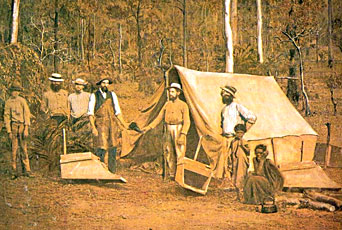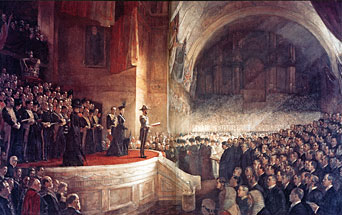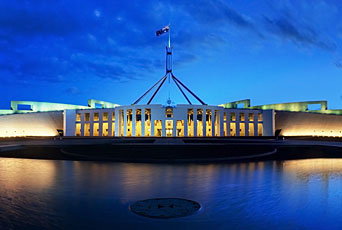| Home |
___ History of Australia |
HISTORICAL BACKGROUND  Aborigines from Bathurst Island (1939), one of the Tiwi Islands in the Northern Territory.  Captain James Cook (1728 – 14 February 1779) James Cook was a British explorer, navigator and cartographer, he reached the south-eastern coast of Australia on 19 April 1770, his expedition became the first recorded Europeans to have encountered Australia's eastern coastline. In 1779 Joseph Banks recommended Botany Bay, named after the profusion of new plants found there, as a site for a penal settlement. A new outlet was needed for convicts to be transported overseas in continuance of British penal policy after the loss of the 13 North American colonies. In 1786 the British government decided to adopt Bank’s recommendation. Considerations other than the pressing need to reduce the convict population may have influenced Lord Sydney, the home minister, in his action. There was, for example, some expression of interest in supplies for the Royal Navy and in the prospects for trade in the future. The first fleet in the series that transported convicts arrived in January 1788, bringing 1,500 people, nearly half of them convicts. On January 26, Captain Arthur Phillip of the Royal Navy raised the British flag at Sydney Cove, which he decided was preferable to Botany Bay, slightly to the south, as a settlement site. The colony of New South Wales was formally proclaimed on February 7, 1788. Transportation of convicts eventually brought a total of about 160,000 prisoners to Australia. The initial character of a penal colony lasted for about 60 years in the areas of major original settlement. It ended in 1840 in New South Wales and in 1852 in Van Diemen’s Land (modern Tasmania), which became a colony in 1825. Western Australia, which was founded in 1830 by free immigrants, added convicts to its population by its own choice from 1850 to 1868. Convicts were not sent to South Australia, which became a colony in 1836. The major continuing problems of the colonies arose from efforts to carry out British policy designed for a penitentiary when other interests—fishing, sealing, farming, and trade—were developing. The economic development begun in the convict phase of settlement included the expansion of agriculture where conditions were favorable, as in Van Diemen’s Land, which started in 1815 to export grain to New South Wales. Roads, bridges, and other transportation facilities necessary for commerce were built by convict labor, as were government buildings. In the early nineteenth century, enterprising colonists successfully introduced merino sheep as a source of the fine wool increasingly demanded by the expanding British textile industry. Individual immigrants to Australia increased in number in the 1820s. They were mostly people of some means with which to acquire land, which was in general granted only to those of substance. This land policy, favoring the so-called exclusives, or individuals of established position, over the freed convicts, or emancipists, who sought to advance themselves, facilitated the pastoral expansion of the 1820s. The colonies already established—New South Wales and Van Diemen’s Land—got most of the early immigrants, but some immigrants went to the newer colonies, Western Australia and South Australia. In the 1830s, the southern part of New South Wales, which later became the colony of Victoria (1851), was occupied by sheepmen from farther north and from Van Diemen’s Land. Thus, this portion of Australia was originally settled by migration within Australia.  Aboriginal Rock Art, Anbangbang Rock Shelter, Kakadu National Park, Australia. Photo: © Thomas Schoch |
||
 Settlement of prospectors during the gold rushes in Australia. Gold was discoverd in 1851and led to the Victorian gold rush during this era Victoria dominated the world's gold output. The Australian colonies became self-governing while undergoing great changes caused by the discovery of gold in 1851. Gold was, in fact, a cause for the change in attitude of the British government, which considered that the increasing wealth as well as the growing population of the colonies justified their assumption of political responsibility. The discovery of gold, first in New South Wales and soon afterward in the new colony of Victoria, led to an influx of newcomers, including professional and skilled people. In the 1850s, Victoria produced more than one-third of the world’s gold. Between 1852 and 1870, gold’s export value was greater than that of wool. Most Australian gold was exported to Britain, which used it to maintain a gold standard for the pound. Agriculture, transportation, and industry developed from the 1850s to meet the demands of the increasing population. South Australia, largely through its own capital resources, increased wheat output sharply, started the manufacture of agricultural machinery, and pioneered river transport to ship grain to Victoria. The colonial governments of New South Wales and Victoria undertook to build railroads, but the selection of different gauges was the origin of an eventual major problem in transportation. Industries of all sorts—processing, manufacturing, and engineering, including foundries and shipyards—were established in Sydney and Melbourne. Western Australia and Tasmania, however, did not experience similar development. The pastoral industry adapted in part to changing conditions by greatly increasing cattle breeding for both beef and dairy products, which required less labor than sheep, and by slaughtering sheep for mutton. Where capital was available—chiefly in Victoria—station owners started to fence their sheep runs as a means of reducing their need for shepherds. Wool shippers benefited greatly from improved ocean shipping, which increased the frequency and decreased the cost and elapsed time of voyages to and from Britain. The suddenly increased pressure on the land resources of New South Wales and Victoria beginning in the 1850s resulted in a popular movement against squatting and squatters; the slogan was “Unlock the Lands” to permit the formation of new wheat and dairy farms. The colonial governments were powerless to resolve the conflict until 1856, when their newly acquired constitutions gave them control of the disposition of public lands. Land reform laws were finally enacted in the 1860s after bitter political struggles. The elaborate provisions of the laws proved in many cases to be of more benefit to squatters than to would-be settlers. The 1870s and 1880s were decades of great economic development in the Australian colonies. Farming expanded as railroads penetrated the coastal ranges of the southeast and more land became accessible. Irrigation works were extended and improved, specialized machinery was invented (for example, the so-called jump-stump plow), and improved seeds and farming methods contributed to higher yields. By the late 1880s, the volume of investment had led to spiraling speculation, especially in Victoria, where the boom reached its greatest height and where the subsequent collapse was eventually the greatest. Low wool prices and a severe drought brought about a depression in the 1890s. |
||
 The opening of the first Parliament of Australia in 1901. Expansion of the Australian economy in the first decade of the twentieth century was followed by an increase in immigration, which totaled 200,000 from 1911 to 1913 (population growth at that time was slowest in Victoria and fastest in Western Australia). Wool production reached a new high level, although the numbers of sheep had not quite regained the peak of 1891 after the serious damage of drought years to the pastoral industry. Tariff protection on a national basis encouraged an increase in the number of factories, in manufacturing production, and in industrial employment. Most industry was small scale, much of it concerned with processing agricultural commodities. The Australian steel industry started in 1905 when a blast furnace was built in New South Wales. As part of the British Empire, Australia joined forces with Britain in World War I. Australian forces during World War I—all volunteers—totaled 416,809, drawn from a population that did not reach 5 million until 1918. Nearly 330,000 served overseas in army, navy, and flying corps units. They incurred 226,000 casualties, including 60,000 killed. Australian forces took part in the naval and landing actions that eliminated the German presence in the South Pacific early in the war. Australian troops also participated in the campaigns in the Middle East that ended with Turkey’s surrender. Australia’s economy and politics were profoundly affected by the scope of the measures that the government took to support the country’s war effort. The pattern of industry and employment changed, in part to provide substitutes for products unobtainable from Britain during the war. Despite the growth of manufacturing and industrial employment, unemployment was high—greater than 6 percent—and the Australian economy was not prosperous during the war years. In World War II, the reaction was the same as that of 1914; Australia was automatically at war without further formality when Britain declared war on Germany on September 3, 1939. Again forces were sent to the Middle East. The Royal Australian Air Force was rapidly expanded, and some of its units took part in the Battle of Britain in 1940. In the difficult military campaigns that finally succeeded in eliminating or neutralizing Japanese military forces in the islands to the north and northeast of Australia, Australian army, navy, and air force units played a major role. Australia proper was not invaded but was subjected to 96 attacks by air, which included severe damage to Darwin. Some 691,400 men and women served in Australia’s armed forces during six years of war. Casualties numbered about 71,000, of whom more than 29,000 were killed and almost 2,500 were missing; 30,000 were taken prisoner, of whom 8,000 died in captivity. Australia Since 1945: In the post-World War II-era, Australia’s foreign policy became more closely aligned with the United States than with Britain. Another foreign policy theme has been collective security. Australian forces participated in the Korean War (1950–53) in support of the United Nations (UN)-sponsored campaign. In 1951 Australia signed the Australia-New Zealand-United States (ANZUS) Security Treaty, which committed the three nations to mutual defense. In 1954 Australia helped found the Southeast Asian Treaty Organization (SEATO), which was the regional equivalent of the North Atlantic Treaty Organization (NATO). From 1965 to 1971, Australia sent troops to Vietnam in support of the United States-led intervention there. In 1990 Australia deployed three ships to support the United States-led naval blockade of Iraq following Iraq’s invasion of Kuwait. After the September 11, 2001, terrorist attack on the United States, Australia invoked the ANZUS treaty and dispatched troops to Afghanistan. In 2003 Australia also sent troops to participate in Operation Iraqi Freedom. Australia was rewarded for its unwavering friendship with the United States when the two nations began to observe a bilateral free-trade agreement in January 2005. At the same time, Australia is developing an increasingly close relationship with China, and the two nations are pursuing a free-trade agreement. |
||
 The New Parliament House in the city of Canberra is the meeting place of the Parliament of Australia. Construction began in 1981, the building was opened by Queen Elizabeth II on 9 May 1988. Photo: JJ Harrison Australia’s relations with some of its Asian neighbors have suffered from time to time because of Australia’s firm positions on immigration, terrorism, and regional security. For example, during the 1980s Malaysian leader Mahathir Mohamad tried to prevent Australia from joining the Asia-Pacific Economic Cooperation (APEC) forum, which ultimately admitted Australia in 1989. Mahathir was able to prevent Australia from joining the Association of Southeast Asian Nations (ASEAN), but Australia has become a dialogue partner of that organization. In 1999 Australia entered into a period of strained relations with Indonesia when Australia joined the UN-sponsored intervention in East Timor, which declared its independence after it was annexed by Indonesia in 1975. However, Australian-Indonesian relations took a notable turn for the better following Australia’s generous aid after the tsunami disaster in December 2004. Source: Library of Congress |
||
| More about Australia: Landmarks: Cities, searchable map and satellite view of : Country: Continent: External Australia HistoryLinks: Ancient heritage, modern society Australia's history. Australian History on the Internet A useful guide by the National Library of Australia. Documenting a Democracy - Australia's story The (hi)story of Australia's Democracy. The National Archives of Australia We care for valuable Commonwealth government records and make them available for present and future generations to use. Royal Australian Historical Society Founded in 1901 to encourage Australians to understand more about their history. Society of Australian Genealogists Website of the Society of Australian Genealogists, Australia's first family history society. Wikipedia: History of Australia Wikipedia article about the History of Australia. |
Bookmark/share this page
|
|
| Explore more:
|
||
One World - Nations Online .:. let's care for this planet Made to improve cross-cultural understanding, global awareness, and cultivating a cosmopolitan consciousness. |
 |
|
| Site Map
| Information Sources | Disclaimer: Privacy Policy, etc. | Contact:
[email protected]
Copyright © 1998-2017 :: nationsonline.org | ||